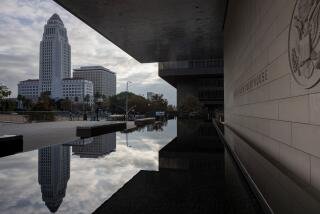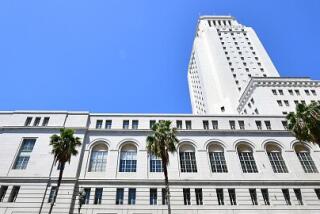Jury Rejects Bicyclist’s $23-Million Injury Suit : Courts: Woman contended a crack in a Huntington Beach street caused 1987 crash that left her a quadriplegic. Observers say the decision reflects a trend to hold plaintiffs to a higher burden of responsibility.
- Share via
SANTA ANA — Six years ago, Victoria S. Haserot was a nationally ranked competitive bicyclist who logged 30,000 injury-free miles. Today, the former Laguna Niguel resident is a quadriplegic living in a rehabilitation center, struggling to regain control of her life.
Haserot, 52, wept Wednesday as she learned that a jury had rejected her lawsuit against the city of Huntington Beach, which she blamed for the 1987 biking accident on Pacific Coast Highway south of Beach Boulevard that left her with a broken neck and no use of her limbs.
Her lawyer was seeking $23 million in damages.
“I kind of thought that might be the outcome,” Haserot said from her convalescent home in Los Angeles.
The Orange County Superior Court jury deliberated 90 minutes Tuesday before unanimously finding the state and the city were not responsible for the biking accident. Haserot, who was wearing a helmet at the time of the injury, contended that a crack in the road caused the crash that sent her sailing head first over her handlebars. Government attorneys blamed the crash on rider error.
The stakes were especially high for the city, which went without liability insurance in 1987.
“It’s been like the sword of Damocles hanging over our head,” said Huntington Beach City Atty. Gail C. Hutton, who feared that the jury might side with the victim out of sympathy and assume the city’s “deep pockets” could pay damages.
Some say the case points to a growing shift among jurors to hold people who file lawsuits to a higher burden of responsibility. Attorneys for both sides said jurors looked at the evidence carefully and refused to let their emotions sway them. Jurors could not be reached for comment Wednesday.
“I’ve noticed recently that the pendulum seems to be swinging back a bit to where jurors look at these cases in terms of individual responsibility, and not just a matter of who can bear the loss, but obviously there are cases that go the other way, too,” said attorney Neal Moore, who represented the city at the trial.
Moore stressed personal responsibility in his case. He noted that Haserot was not riding along the shoulder of the slow lane, but traveling in the second lane over.
“She was not in an area where bikes should be. My question was: ‘Why was she there?’ A reasonable bicyclist would not have been in the roadway there,” Moore said.
Haserot’s San Francisco-based attorney, Jack Slobodin, dismissed the notion that the case hinged on matters of personal responsibility. Instead, he said, jurors focused on the evidence--or lack of it.
The lawsuit was filed in 1989, so attorneys on both sides were unable to survey the scene of the crash as it appeared at the time. Aerial photos taken by road workers for an unrelated project became key to the case, and both sides brought experts to the witness stand to testify about road conditions.
In the end, Slobodin said, he could not present enough evidence to convince jurors that the crack was indeed there.
“It was as simple as that,” he said.
Attorneys on both sides agreed that Haserot was a sympathetic figure.
“The jurors told me they thought she was a very strong, brave person,” said Slobodin, who said his client is working toward a career in rehabilitation counseling. “She really is an exceptional person.”
Hutton said Huntington Beach was unable to get liability insurance in 1987 because of a municipal insurance crisis that affected many cities in the county. The city is now insured.
Santa Ana City Atty. Edward J. Cooper, like other municipal leaders, said he worries about lawsuits whenever an injury occurs within city limits. Cooper said he would welcome a trend toward placing emphasis on personal responsibility. When jurors award damages based on emotion--and not the evidence--the citizens are ultimately hurt, he said.
“Juries just seem to forget that the taxpayers are footing the bill--and that they are taxpayers,” Cooper said.
Christopher J. Day, a medical malpractice and personal injury attorney who is also an adjunct professor at Western State University College of Law in Fullerton, said he detects a shift by jurors to hold plaintiffs to a higher burden. But Day said that hasn’t stopped individuals from filing frivolous lawsuits.
But Day also noted that such a backlash could harm plaintiffs who have suffered legitimate injuries.
“I think juries these days are getting stingier and stingier and there is a perception that no one wants to take responsibility for themselves, but they’re willing to blame someone else,” he said.
More to Read
Sign up for Essential California
The most important California stories and recommendations in your inbox every morning.
You may occasionally receive promotional content from the Los Angeles Times.











